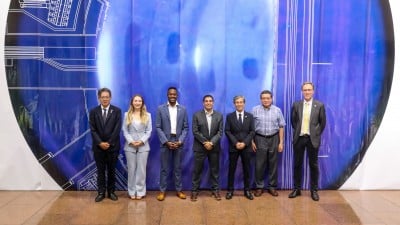Science
Princeton Laboratory to Enhance World’s Largest Fusion Project

The Princeton Plasma Physics Laboratory (PPPL) will play a pivotal role in advancing fusion energy research by contributing critical measurement technology to the world’s largest superconducting fusion machine, known as JT-60SA. This partnership marks a significant milestone as it represents one of the first contributions to this ambitious fusion project from an institution outside Japan and Europe.
Constructed in Japan, the JT-60SA is designed to explore the capabilities of plasma, the fourth state of matter, which is crucial for achieving sustainable nuclear fusion. The project’s goal is to harness fusion energy as a safe and virtually limitless source of power. The fusion machine is expected to provide insights that could accelerate the development of commercial fusion reactors in the coming decades.
Key Contributions to Fusion Technology
The PPPL’s advanced plasma measurement system is expected to enhance the operational efficiency of JT-60SA, enabling researchers to gather more accurate data on plasma behavior. This technology involves sophisticated instruments capable of monitoring various plasma parameters, which is essential for optimizing fusion processes.
The collaboration reflects an expanding international effort in fusion research, emphasizing the importance of shared knowledge and technology. According to Dr. Steven Cowley, director of the PPPL, “Our contributions are vital for understanding how to control and sustain plasma, which is a fundamental challenge in making fusion energy a reality.”
With the global energy landscape shifting towards sustainable solutions, the insights gained from the JT-60SA could lead to breakthroughs in fusion technology. The project is part of a broader commitment to research and development in clean energy, aligning with international climate goals.
Future Implications for Energy Production
As nations seek to reduce dependence on fossil fuels, fusion energy presents a promising alternative. Unlike traditional nuclear power, fusion produces minimal radioactive waste and has a lower risk of catastrophic failure. The successful operation of JT-60SA could provide the necessary data to inform future designs of commercial fusion reactors.
The collaboration between the PPPL and the JT-60SA project underscores the global nature of scientific research and the urgency to find sustainable energy solutions. By leveraging American technology in this groundbreaking project, the initiative not only enhances scientific understanding but also fosters international partnerships that are crucial for tackling global energy challenges.
The work at the JT-60SA is expected to continue into the next decade, with significant advancements anticipated in the field of plasma physics. As the project unfolds, the scientific community will closely monitor its developments, hoping for significant strides in fusion energy that could reshape the future of power generation.
-

 Science2 months ago
Science2 months agoUniversity of Hawaiʻi Joins $25.6M AI Project to Monitor Disasters
-

 Business2 months ago
Business2 months agoForeign Inflows into Japan Stocks Surge to ¥1.34 Trillion
-

 Top Stories2 months ago
Top Stories2 months agoBOYNEXTDOOR’s Jaehyun Faces Backlash Amid BTS-TWICE Controversy
-

 World2 months ago
World2 months agoBoeing’s Merger with McDonnell Douglas: A Strategic Move Explained
-

 Top Stories2 months ago
Top Stories2 months agoCarson Wentz Out for Season After Shoulder Surgery: Urgent Update
-

 Entertainment2 months ago
Entertainment2 months agoSydney Sweeney Embraces Body Positivity Amid Hollywood Challenges
-

 Top Stories2 months ago
Top Stories2 months agoMarc Buoniconti’s Legacy: 40 Years Later, Lives Transformed
-

 Lifestyle2 months ago
Lifestyle2 months agoKelsea Ballerini Launches ‘Burn the Baggage’ Candle with Ranger Station
-

 Health2 months ago
Health2 months agoInnovative Surgery Restores Confidence for Breast Cancer Patients
-

 Sports2 months ago
Sports2 months agoSteve Kerr Supports Jonathan Kuminga After Ejection in Preseason Game
-

 Entertainment2 months ago
Entertainment2 months agoZoe Saldana Advocates for James Cameron’s Avatar Documentary
-

 Science2 months ago
Science2 months agoChicago’s Viral ‘Rat Hole’ Likely Created by Squirrel, Study Reveals









